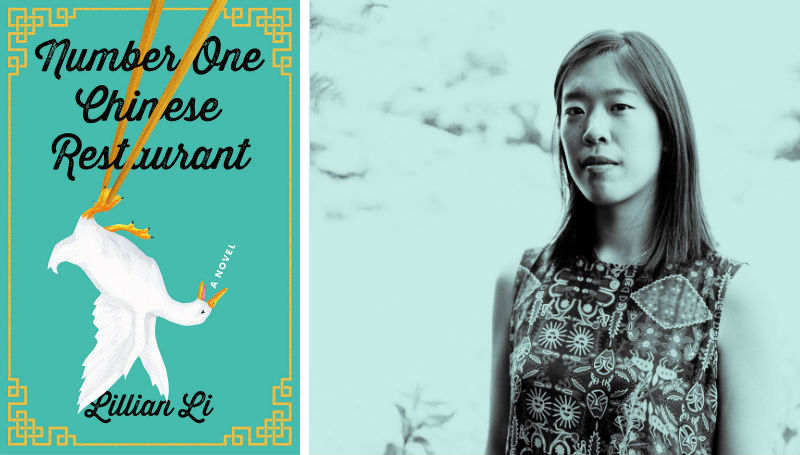A2 author Lillian Li explores relationships, context, and proximity in her debut novel

This story was originally published on September 12, 2018.
How do obligations and desires compete in our lives?
Three generations of characters, family, and friends grapple with those two often opposing components in Number One Chinese Restaurant, the debut novel by Lillian Li.
Li presents a broad cast, ranging from restaurant staff to the family members who own the Beijing Duck House. In fact, the family tree -- or rather the map of characters -- is on the inside cover of the book, which proves quite useful when reading. (You can have your book signed by Li at Nicola’s Books on September 20 at 7 pm.)
The Ann Arbor-based Li teaches at the University of Michigan and works at Literati Bookstore. She earned her MFA from the University of Michigan and is originally from the D.C. metro area.
Having previously worked in a food service jobs myself, Li’s following description of her stint in a Chinese restaurant conjures up memories of my situation-specific relationships, responsibilities, and interactions. Those of us who have worked in any customer service role will relate to her feelings about this source of inspiration for her book. Regardless, it is the restaurant around which everyone’s life centers in this novel and also that which produces the main conflict of the novel.
Li writes from experience and shares insights about her writing, plot, and characters with Pulp.
Q: Tell us about your experiences with Chinese restaurants and how you came to write about them.
A: I happened to work, very briefly, as a waitress in a Chinese restaurant the summer before I came to Michigan for grad school. I had no intention of writing about that experience; in fact, it was only months after I quit that job that I realized I might want to write a book that takes place in a Chinese restaurant.
I thought I’d quit largely because of the physical challenge of waiting tables, and that once the aches went away, it would be like those weeks never happened and I could put the entire thing behind me. Instead, once my feet and fingers stopped hurting, I felt a different kind of pain, an emotional ache that was hiding behind the physical one. I realized that those few weeks in that restaurant space had been incredibly lonely and alienating, that I was spending 12 hours a day, six days a week, serving people who treated me and my co-workers like furniture, who looked right through us. I couldn’t imagine anyone lasting in that kind of environment for longer than I did (just four weeks). Yet, all of my co-workers had, and they didn’t look shattered at the end of every night.
So then, I couldn’t stop imagining working that job for longer than I did! What that kind of environment would do to a person over the years. And what a person might do to make a sustainable life inside those restaurant walls. What would they do to find connection, dignity, and even love? What would they be willing to give up in their outside lives in order to make that possible? It was really through this compulsive imagination that I wrote Number One Chinese Restaurant.
Q: Much of Number One Chinese Restaurant is dialogue, and it feels very natural. Was this how the novel unfolded for you or an intentional style?
A: Thank you! It’s funny, whenever I have to read the dialogue I’ve written at an event, I think it’s the most unnatural, stilted thing I’ve ever seen, so it’s always nice to hear that I’m being too critical of myself. I’d say that I was intentional about making the dialogue, especially the dialogue belonging to the Chinese-speaking characters, feel as natural as possible. I’d noticed in other, often older, books with Chinese characters that even when they’re supposedly speaking in their native tongue, there’s a stilted quality to their speech. They don’t use contractions, don’t use slang, and never curse! I mean, Chinese people (like most people) LOVE to curse. So that should be what’s represented when they show up on the page. It was really important for me to erase that linguistic stiffness in my work, but at the same time, it was easy to do so. I just wrote what I hear in my head.
Q: Amidst the dialogue are keen observations of life and relationships. I have to ask about this passage: “Americans. They believed a strong marriage came from knowing their partner’s every shadowy thought. But it was knowing too much that killed love. A strong marriage came when the wedded stopped trying to plumb their partner’s depths. Life became easier when one passed the years with an amiable stranger and not a mirror that reflected back all of one’s flaws. Marriages were torn apart by empathy; to look into her eyes and find pity was to discover what she pitied in the first place. Intimacy was not to know but to wonder. Eyes that searched in their staring were the hallmark of every lover’s gaze. And if the search was lazy, unstructured -- a slow, easy stroll rather than a rush to the finish -- then in this stretch of time, forever might comfortably rest.” How did you shape this outlook?
A: The clever loophole of the close third P.O.V. is that you can say you’re only speaking for whichever character is currently in the driver’s seat of your narrative. So that passage is in Ah-Jack’s perspective, and therefore it’s more his outlook than mine. How I shaped his outlook was that I had to think about how his cultural background, his life’s journey, his current relationship with his wife, and his personality all formed his views on marriage. Essentially, I asked, what is he telling himself about the world around him, and why?
Q: Yet something falls apart for each character. What compelled this breakdown?
A: Much of the plot hinges on the main restaurant in the novel, the Beijing Duck House, suddenly disappearing from the lives of the characters. Here’s this institution that has essentially been at the center of everyone’s world for three decades, structuring the literal days of their lives. It has allowed certain relationships to thrive, and others to suffer; it’s dictated where people spend the bulk of their days and even what they are and are not allowed to do. So of course, when that structure and its rules are taken away, there’s nothing left to hold the characters up. Many the characters are forced to examine, sometimes for the first time, how they’ve chosen to spend the last 30 years of their lives, and if that doesn’t equal a breakdown, I don’t know what does.
Q: This novel captures the realities and flaws of characters, from betrayals to burping. How do you relate to your characters?
A: I love my characters, and I guess for me, love means seeing someone fully and clearly, rather than seeing them in their best light. I think it’s also true that all my characters share either some trait/behavior with me, or with someone I love in real life, and that makes them feel familiar, even as I’m writing to get to know them better.
Q: There are so many passages that I underlined while reading, too many to ask you about -- and too revealing for people who haven’t read the book! One that I related to is about stress. You write, “‘Stressed’ -- what was that word? Americans used it all the time, and Ah-Jack always translated the word in his head to ‘pressure,’ which made more sense. They were all under a lot of pressure with their new jobs and new living arrangements. Happy as these changes had made him, the weight of the newness was crushing.” How do you see the characters responding to this “pressure?” Succumbing to it or perhaps overcoming it?
A: I think pressure is a humbling thing. Whether you overcome or succumb to enormous pressure, it reveals your tender spots, and your dark spots, too. So I would say that each of my characters is ultimately humbled by the pressure they face, which is not the same thing as saying that they’re changed by the experience. They learn something about themselves that they didn’t know, or hadn’t wanted to know, and some make changes based on those lessons, and others don’t.
Q: Could you speak to some of the elements with which readers might be unfamiliar, such as “Ah” preceding names?
A: Sure. It’s essentially a little nickname you put in front of someone’s name if you’re close, like in an almost familial way. Kind of like calling someone who isn’t related to you your brother or cousin.
Q: Back to the topic of relationships, I loved these sentences: “This was the problem with indescribable relationships. They had no limits but also no rules, no boundaries. The only thing holding them together was the strangeness and majesty of their love. Was this enough?” To me, some of the relationships in the novel find that it is enough, and others do not in your novel. It seems like you ask this of the characters and let them work their way to the answer.
A: In general, I like to let my characters work things out for themselves. I started writing by writing fan fiction in fifth grade, and fan fiction, for me at least, was all about getting these totally developed characters that you steal (or rather, borrow) from a movie, or book, or TV show that you love, and seeing what they do in your hands. So, for this novel, I spent a big bulk of writing time figuring out who my characters were, what their personalities and behaviors are like, so that I could let them roam free and just follow wherever they led me.
Q: One passage particularly stands out to me as representative of the characters and how they do not quite know what they are doing. It reads, “He didn’t know where he was lying and where he was telling the truth and where he was simply confused. He only knew that this reality was the safest one to believe in. He was learning to protect himself.” This character, Ah-Jack, cannot determine truth but seems to choose what feels right. The characters struggle with their conflicting obligations and desires. How did you grapple with this as you wrote?
A: I feel like most people can empathize with the feeling of not knowing what they’re doing, the feeling of being pulled in multiple and often contradictory directions at once, and it’s so interesting to see which direction wins out over all the rest. I think the challenge was not how to write the characters’ struggles with their obligations and desires, but rather coming up with the right combination of obligations and desires that would truly be a struggle for them to figure out. How to create stakes that feel life-or-death without actually being life-or-death.
Q: The novel is set in the microcosms of the restaurants and relationships. Nan reflects, “She hadn’t expected to learn such an unkind lesson this late in life, of the fleeting nature of friendship built on context and proximity.” It could be said that much of what happens is based on those two things. How did this structure influence your writing?
A: I think a lot of stories are based on context and proximity. Essentially a story is asking, “Who are these people and why do they matter?” and combining that answer with, “And why were they in the right/wrong place at the right/wrong time?” Or maybe that’s a formula I just made up that I can now base all my future novels on!
Martha Stuit is a former reporter and current librarian.
<Lillian Li reads and signs "Number One Chinese Restaurant" at Nicola’s Books, 2513 Jackson Ave., Ann Arbor, on September 20 at 7 pm.


































